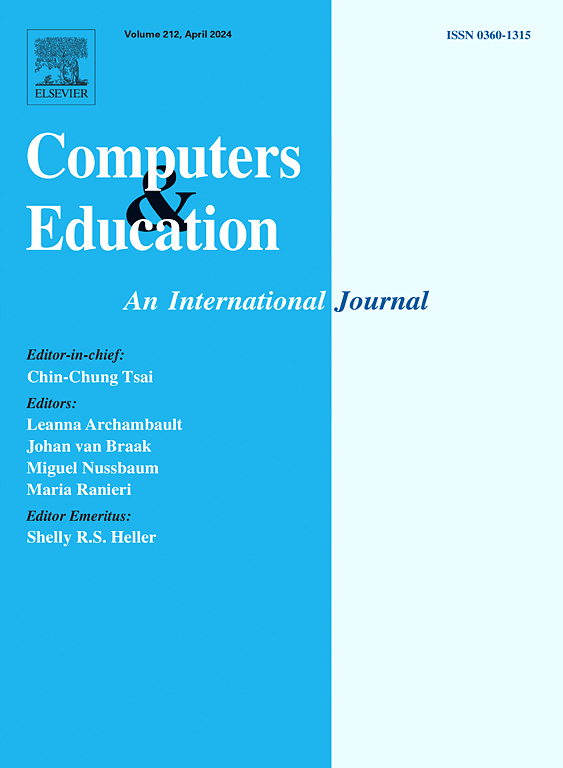在VR中,时间很重要:学生从较长的VR课时中受益,但在45分钟后,某些结果会下降,个体差异很大
IF 10.5
1区 教育学
Q1 COMPUTER SCIENCE, INTERDISCIPLINARY APPLICATIONS
引用次数: 0
摘要
虚拟现实(VR)在远程教育中取代或补充视频会议的可能性越来越大,但关于如何构建这些教学体验的知识还存在空白,特别是考虑到相关的理论因素,如社交在场和虚拟会议疲劳。目前的研究解决了这个首要问题:如何将VR技术整合到远程教育中提高学生的成绩,以及确定VR持续时间的最佳教学方法是什么?我们对30名学生进行了一项为期15周的纵向研究,他们通过视频会议和虚拟现实相结合的方式在大学课堂的22次会议中完成了377项调查。与视频会议相比,VR持续时间提供了与教师和同伴更多的社交存在,这两者都与课堂的主观利益相关(例如,感知学习,能力,享受)。然而,在大约45分钟的VR持续时间后,同伴社交存在和感知能力的好处开始下降(学生之间的差异很大),可能是因为VR持续时间增加了会议疲劳。此外,同伴社会存在与虚拟现实持续时间的关系比导师社会存在更强,而导师社会存在与感知学习的关系比同伴社会存在更强。这些发现表明,对于如何将VR技术整合到远程教育中,我们在理论和教学上有了细微的理解。尽管会感到疲劳,但在VR中花费的课堂时间可能会带来净收益,但教师应保持较低的VR持续时间(约45分钟),直到学生熟悉,提供虚拟世界课堂的替代模式,并利用社交参与教学法。本文章由计算机程序翻译,如有差异,请以英文原文为准。

Time matters in VR: Students benefit from longer VR class duration, but certain outcomes decline after 45 minutes, with large individual variance
Virtual reality (VR) is becoming increasingly feasible to replace or complement videoconferencing in remote education, but there is a gap in knowledge about how to structure these pedagogical experiences, especially in consideration of relevant theoretical factors, such as social presence and virtual meeting fatigue. The present research addresses this overarching question: How does integrating VR technology into remote education enhance student outcomes and what are the optimal pedagogical approaches to determining duration in VR? We conducted a longitudinal 15-week study with 30 students who completed 377 surveys across 22 meetings of a university class taught via a combination of videoconferencing and VR. Compared to videoconferencing, VR duration provided more social presence with instructors and peers, both of which were associated with subjective benefits of the class (e.g., perceived learning, competence, enjoyment). However, the benefits for peer social presence and perceived competence began to decline after about 45 min of VR duration (with large variability between students), potentially because VR duration increased meeting fatigue. Further, peer social presence was related more strongly to VR duration than instructor social presence, while instructor social presence was related more strongly to perceived learning than peer social presence. These findings suggest a nuanced theoretical and pedagogical understanding of how to integrate VR technology into remote education. Class time spent in VR likely leads to a net benefit despite meeting fatigue, but instructors should keep VR duration low (∼45 min) until students gain familiarity, offer alternative modes of access to classes in virtual worlds, and utilize socially engaging pedagogies.
求助全文
通过发布文献求助,成功后即可免费获取论文全文。
去求助
来源期刊

Computers & Education
工程技术-计算机:跨学科应用
CiteScore
27.10
自引率
5.80%
发文量
204
审稿时长
42 days
期刊介绍:
Computers & Education seeks to advance understanding of how digital technology can improve education by publishing high-quality research that expands both theory and practice. The journal welcomes research papers exploring the pedagogical applications of digital technology, with a focus broad enough to appeal to the wider education community.
 求助内容:
求助内容: 应助结果提醒方式:
应助结果提醒方式:


